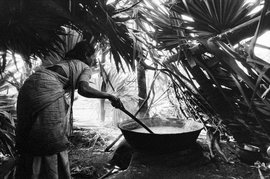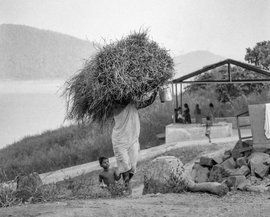The panel is part of Visible Work, Invisible Women, a photo exhibition depicting the great range of work done by rural women. All the photographs were shot by P. Sainath across 10 Indian states between 1993 and 2002. Here, PARI has creatively digitised the original physical exhibition that toured most of the country for several years.
A lifetime bending
She paused, exasperated by the midday sun in Vizianagaram. But remained bent over. She knew she would resume work in moments – in that very posture.
Working in the same cashew fields were two other groups of women from her village. One group had carried its lunch and water two kilometres to the field. The other worked from the reverse direction. All were bent over.
In Rayagada in Odisha, there were also men in the field. Through the lens, it was more spectacular. All the men were standing. All the women, bending. In Nuapada in Odisha, the rain did not stop the woman from weeding. She worked on, bent from the waist. Under an umbrella.
‘Manual’ planting, sowing and weeding are more than hard work. They involve a great deal of time spent in painful postures.
Eighty one per cent of all Indian women workers are cultivators, labourers, forest produce collectors and small livestock handlers. Agricultural tasks show a strong gender divide. Women are barred from ploughing. But they almost exclusively perform operations like transplanting, weeding, harvesting, threshing and also do post-harvest work.
According to one analysis, women form:
32 per cent of the work force that prepares the land for cultivation;
76 per cent of those sowing seeds;
90 per cent of people engaged in transplantation;
82 per cent of those transporting the crop from field to home;
100 per cent of workers processing food; and
69 per cent of those in dairying.


Most of these activities mean a lot of bending and squatting. Besides, many of the tools and implements used were not designed for the comfort of women.
The work women do in the fields sees them move forward constantly while bending and squatting. So, severe pain in the back and legs is very common. Often standing shin-deep in water during transplantation, they’re also exposed to skin diseases.
Then there’s injury from implements made for men and never refashioned for women. Injuries from sickles and machetes are common and decent medical care is rare. Tetanus is a constant threat.



High infant mortality is a big problem of such work in agriculture. During transplantation work, for instance, women remain bent or squatting for much of the day. A study in Maharashtra showed that this is the period which sees the highest number of miscarriages and infant deaths. Prolonged squatting sparks off strains and stresses that often lead to premature births.
Also, women workers don’t get to eat enough. Their general poverty ensures this. And the custom of serving the family first and eating last worsens it. Pregnant women don’t get to eat any better, though they need to. Since the mothers are anyway under-nourished, premature babies are too underweight to survive.
So women agricultural workers are caught up in a cycle of repeated pregnancies and high infant mortality, which further devastates their health. Large numbers die during pregnancy and childbirth.




